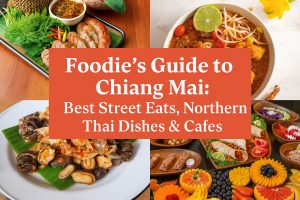
Foodie’s Guide to Chiang Mai: Best Street Eats, Northern Thai Dishes & Cafes
If you think Chiang Mai is only known for its ancient temples and Lanna-style architecture, then you are wrong; it’s also a paradise for food lovers. From sizzling night markets to cozy mountain-view cafes, the city is brimming with flavors that reflect centuries of history and a melting pot of cultures. What makes Northern Thai cuisine so unique is how different it is from the food you’ll find in Bangkok or the south. Forget the heavy use of coconut milk and seafood; here, the focus is on earthy spices, smoky flavors, sticky rice, and a perfect balance of sour, salty, and herbal notes. Meals are often shared family-style, with small plates that encourage tasting and variety. The flavors of Chiang Mai tell the story of its past. Rooted in Lanna heritage, the food has been shaped by Burmese curries, Shan and Yunnanese noodle traditions, and the freshness of hill-tribe ingredients. The result is a cuisine that’s hearty, comforting, and deeply tied to the region’s identity. In this guide, we’ll take you through Chiang Mai’s culinary journey, from bustling street food stalls serving quick bites to traditional dishes you can’t leave without trying, and finally, the city’s thriving modern cafe culture that blends global trends with local charm. Whether you’re a curious traveler or a dedicated foodie, Chiang Mai promises an unforgettable dining adventure. Northern Thai Cuisine – A Primer If Bangkok is all about spicy curries and seafood, Northern Thai cuisine is a completely different world. Here in Chiang Mai, food feels slower, heartier, and deeply rooted in tradition. Meals revolve around sticky rice, rolled into small balls and eaten with your hands, paired with a variety of dips, curries, and grilled meats. The flavors are bold yet balanced. Instead of fiery heat, you’ll often find herbal freshness and smoky depth. Ingredients like galangal, turmeric, kaffir lime, lemongrass, and homemade chili pastes set the tone, giving Northern dishes their distinctive aroma. Many recipes also feature fermented elements from pickled vegetables to preserved fish, which add layers of tanginess and umami. This unique cuisine is a product of Chiang Mai’s history and geography. Burmese influences brought rich, slow-cooked pork curries; Lao traditions shaped the famous laab (minced meat salad); while Yunnanese settlers introduced comforting noodle soups. All of these culinary threads come together to create a tapestry of flavors you won’t find anywhere else in Thailand. Dining in the north also has its rhythm. Meals are often shared family-style, with a spread of curries, chili dips, fresh and steamed vegetables, and grilled meats. Sticky rice is the anchor, eaten with your hands to scoop up dips or paired with meat. It’s a communal way of eating that makes every meal feel like a celebration. Take your taste buds on a vacation and try Northern Thai Cuisine with us, and make it more flavorful and tasteful. We promise your stomach will not be mad at you in this food run. Chiang Mai Street Food Scene When the sun sets in Chiang Mai, the city transforms into a bustling kitchen. Markets spill over with sizzling woks, fragrant curries, and endless trays of skewers, dumplings, and sweets. If you are in hunt for legendary dishes or just grazing through the stalls, these night markets are the beating heart of the city’s food culture. Famous Street Food Markets 1. Chang Phuak Gate (North Gate) Night Market In Chang Phuak Gate Night Market, you’ll find the city’s most iconic street food vendor, the Cowboy Hat Lady, famous for her tender Khao Kha Moo (stewed pork leg over rice). Affordable, hearty, and packed with locals every night, it’s a must-stop for food lovers. 2. Chiang Mai Gate Market (South Gate) By day, Chiang Mai Gate Market it’s a hub for fresh produce, fruits, and breakfast bites like rice porridge and fried dough sticks. By evening, the gates come alive with street stalls selling everything from grilled chicken to mango sticky rice, perfect for an authentic local dinner. 3. Warorot Market (Kad Luang) Warorot Market holds the true taste of Northern Thailand. Here you’ll find traditional nam prik (chili dips), sausages, dried herbs, and spices ideal for anyone wanting to explore Chiang Mai’s food culture beyond street snacks. It’s less touristy and more of a local’s market. 4. Sunday Walking Street (Tha Pae Gate) If a foodie’s dream and a cultural feast rolled into one place, then it is Sunday Walking Street. Alongside handicrafts and souvenirs, you’ll find endless rows of street eats, think crispy spring rolls, grilled skewers, coconut ice cream, and sweet pancakes. It’s crowded but worth the stroll. 5. Saturday Wua Lai Walking Street Saturday Wua Lai Walking Street is smaller and less chaotic than Sunday’s version, but just as delicious. The street is lined with stalls serving local snacks, Northern curries, and fresh juices, all while you browse traditional silverware and handmade crafts. 6. Chiang Mai Night Bazaar Chiang Mai Night Bazaar is more tourist-oriented, but still great if you want variety under one roof. With dedicated food courts and stalls serving Thai, Chinese, and even Indian dishes, it’s an easy place to sample different flavors in one go. Must-Try Street Food Dishes Chiang Mai’s street food isn’t just about filling your stomach; it’s about discovering flavors that tell the story of the north. From rich curries to simple grilled bites, here are the dishes you absolutely shouldn’t miss: 1. Khao Soi Khao Soi is the crown jewel of Northern Thai cuisine. This coconut curry noodle soup combines silky egg noodles, tender chicken or beef, and a rich, slightly spicy broth, topped with crispy noodles, pickled mustard greens, and lime. Creamy, tangy, and utterly comforting. 2. Sai Oua (Northern Thai Sausage) Chiang Mai Street vendors have a street food superstar, then it should be Sai Oua. Packed with herbs, lemongrass, kaffir lime leaves, and chili, this grilled pork sausage bursts with flavor in every bite. Best enjoyed with sticky rice and a spicy dipping sauce. 3. Nam Prik Ong & Nam Prik Noom The duo of










